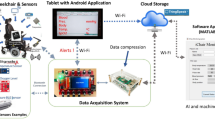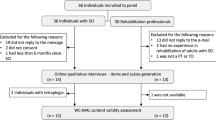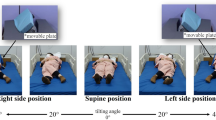Abstract
The functional requirements for daily living at home are the same for a ventilator dependent quadriplegic person as they are for anyone, whether less severely disabled or able bodied. In persons with high spinal cord lesions, the necessary presence of a carer near to hand should not deter the use of assistive technology to increase independence.
Maximised independence is desirable to free the carer from minute by minute tasks such as turning pages, switching lights, TV etc. This not only frees the carer for other tasks, making the caring task more bearable (and thus easier to recruit carers) but also vastly improves the morale of the disabled person. Some assistive devices, especially those concerned with mobility and transfer can avoid the need for multiple carers at times such as toiletting and going on car journeys.
Whichever devices are required by the quadriplegic person, they all clearly need to be worked by a common, carefully selected input interface device matched to his or her preferences and physical abilities for switching.1It is vital to ensure a technical integration of the four generic areas of device functionality: those of mobility (wheelchairs, cars), manipulation (page-turners, robotic arms), communication (keyboard emulators, voice processors, artificial speech) and control of the environment. In most countries this integration is poorly addressed owing to the different agencies involved in the provision of devices relating to each of these generic areas–despite the technology being available today.
The Keep Able Foundation has developed a semimodular approach (ability trolleys) which can provide a number of different combinations of control methods and of devices to control, integrated across the four generic areas.2
Similar content being viewed by others
Log in or create a free account to read this content
Gain free access to this article, as well as selected content from this journal and more on nature.com
or
References
Barker M R, Cook A M (1981) A systematic approach to evaluating clients’ physical ability for control of assistive devices. Proceedings of the Annual Conference of the Society of Rehabilitation Engineers: 287–289.
Fraser M H, Krishnan K R, Platts R G S, Henny V E, Southall D R (1991) Keep Able Foundation's modular system and its deployment. Proceedings of the first World Technology Conference, Arlington VA, (General Services Administration, Washington DC 20405) WCV2 168.
Krishnan K R, Glass C A, Turner S M, Watt J H W, Fraser M H (1992) Behavioural disturbance in spinal injuries and other intensive care settings. J Am Paraplegic Soc 15(2): 60–65.
Demasco P W, Foulds R A (1982) The design of an ocular-controlled communication system for clinical implementation. Proceedings of the Fifth Annual Conference of the Society of Rehabilitation Engineers: 26.
Efthimiou J, Wayne A K, Gordon W A, Sell G H, Stratford C (1981) Electronic assistive devices: Their impact on the quality of life of high level quadriplegic persons. Arch Phys Med Rehabil 62: 131–134.
Fraser M H (1990) Initial phase of the tetraplegic rehabilitation programme: bringing rehabilitation to the bedside. Revue Européene de Technologie Biomedicale 12(5): 301–302.
Jaffe D L (1983) Ultrasonic head control unit. Proceedings of the Sixth Annual Conference of the Society of Rehabilitation Engineers: 242–243.
Stratford C D, Dickey R E, Zimmerman M E, Sell G H, Youdin M (1980) Voice control: Clinical evaluation by persons with severe physical disabilities with and without speech impairment. Proceedings of the International Conference of the Society of Rehabilitation Engineers: 98–101.
Stephens R, Cottle M (1990) Portable robotic arms and the rehabilitation of spinal injured patients. Revue Européene de Technologie Biomedicale 12(5): 310–311.
Symington D C, Lywood D W, Lawson J S (1986) Environmental control systems in chronic care hospitals and nursing homes. Arch Phys Med Rehabil 67: 322–335.
McFarlane J (1990) RTX/Permobil: the Southport experience. Revue Européene de Technologie Biomedicale 12(5): 306–309.
Bach J R, Zeelenberg A P, Winter C (1990) Wheelchair-mounted robot manipulators. Am J Phys Rehabil 69(2): 55–59.
Prior S D (1990) An electric wheelchair mounted robotic arm—a survey of potential users. J Med Eng Technol 14(4): 143–153.
Cornes P (1987) The impact of new technology on the employment of persons with disabilities in Great Britain. Rehabilitation International and the Commission of European Communities.
Ashok H, Hall J, Huws U (1985) Home sweet workstation: Homeworking and the employment needs of people with severe disabilities. Greater London Council, London.
Hammel J, Hall K, Lees D, Leifer L, Van der Loos M, Perkash I et al (1989) Clinical evaluation of a desktop robotic assistant. J Rehabil Res Develop 26(3): 1–16.
Marsden R (1991) Adapting the Macintosh to become a flexible working aid: a case study. Proceedings of the First World Technology Conference, Arlington VA (General Services Administration, Washington DC 20405) WCV2 137.
Platts R G S, Henny V, Steinberg M (1990) Other robotic devices. Revue Européene de Technologie Biomedicale 12(5): 315.
Weinberg N (1990) Computers in the Information Society. Westview Press, London.
Author information
Authors and Affiliations
Additional information
Paper read at the First European Conference on Domiciliary Ventilation and High Spinal Cord Lesion Southport, England, October 1991.
Rights and permissions
About this article
Cite this article
Platts, R., Fraser, M. Assistive technology in the rehabilitation of patients with high spinal cord lesions. Spinal Cord 31, 280–287 (1993). https://doi.org/10.1038/sc.1993.51
Issue date:
DOI: https://doi.org/10.1038/sc.1993.51



